- Brahms: Songs Without Words
- Mischa Maisky, cello
- Pavel Galilov, piano (Deutsche Grammophon
453-424)
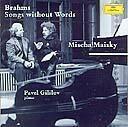 Transcriptions of Brahms songs are common
enough, but I’ve never heard any as beautiful as these for cello and
piano. As with Maisky’s earlier Schubert Songs Without Words
(DG 449-817), he has chosen only the lieder that best suit the
cello’s special sound quality. Maisky is quite simply an interpreter
of genius, caressing an astonishingly tender and expressive sound
from his instrument. The cello sings the vocal line and Galilov’s
piano faithfully follows like a shadow. The recording technicians
have captured every warm detail and delicate nuance. A
masterpiece. Transcriptions of Brahms songs are common
enough, but I’ve never heard any as beautiful as these for cello and
piano. As with Maisky’s earlier Schubert Songs Without Words
(DG 449-817), he has chosen only the lieder that best suit the
cello’s special sound quality. Maisky is quite simply an interpreter
of genius, caressing an astonishingly tender and expressive sound
from his instrument. The cello sings the vocal line and Galilov’s
piano faithfully follows like a shadow. The recording technicians
have captured every warm detail and delicate nuance. A
masterpiece.
Rossini: La Cenerentola
Riccardo Chailly / Teatro Comunale di Bologna
(London 436-902-2)
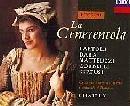 This 1992 studio La Cenerentola with
superstar mezzo Cecilia Bartoli remains one of the most thoroughly
satisfying opera recording projects of our time. The cast is
generally top-notch, with good Italian diction and phrasing and a
genuine understanding of Rossini’s style. Bartoli is the star, her
small but exquisite voice captured at its artful best. Her two nasty
step-sisters are funny but, most importantly, their voices are well
matched for the important duets. Michele Pertusi’s rich, steady bass
is impressive as Alidoro. In the pivotal role of Dandini, baritone
Alessandro Corbelli aspirates his rusty runs but is otherwise
competent. The high tenor role of Ramiro is almost impossible to
cast today. William Matteuzi huffs and bleats his way through the
coloratura runs: an E for Effort. Chailly’s conducting of the superb
Bologna orchestra and chorus is both precise and atmospheric.
Strongly recommended. L'Opéra de Montréal stages Rossini’s La
Cenerentola March 21, 23, 26,
28, April 1,4, 1998. Tel: 985-2258. This 1992 studio La Cenerentola with
superstar mezzo Cecilia Bartoli remains one of the most thoroughly
satisfying opera recording projects of our time. The cast is
generally top-notch, with good Italian diction and phrasing and a
genuine understanding of Rossini’s style. Bartoli is the star, her
small but exquisite voice captured at its artful best. Her two nasty
step-sisters are funny but, most importantly, their voices are well
matched for the important duets. Michele Pertusi’s rich, steady bass
is impressive as Alidoro. In the pivotal role of Dandini, baritone
Alessandro Corbelli aspirates his rusty runs but is otherwise
competent. The high tenor role of Ramiro is almost impossible to
cast today. William Matteuzi huffs and bleats his way through the
coloratura runs: an E for Effort. Chailly’s conducting of the superb
Bologna orchestra and chorus is both precise and atmospheric.
Strongly recommended. L'Opéra de Montréal stages Rossini’s La
Cenerentola March 21, 23, 26,
28, April 1,4, 1998. Tel: 985-2258.
- Alban Berg: Wozzeck
- Arnold Schoenberg: Erwartung
- Dmitri Mitropoulos / New York Philharmonic
(MH2K 62759)
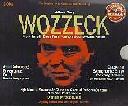 Another exciting
installment in Sony’s Masterworks Heritage series is Dmitri
Mitropoulos’s uncanny 1951 recording — the first ever made — of
Berg’s Expressionist opera Wozzeck. Mitropoulos is second to
none in his comprehension of Berg’s intentions, and the subtle
playing he wrings from the New York Philharmonic remains admirable
by today’s standards. The string section’s brilliant work is
especially well defined in this digital remastering. The singing and
acting of the principals (Eileen Farrell as Marie, Mack Harrell as
Wozzeck, Ralph Herbert as the Doctor, Joseph Mordino as the Captain)
are convincing, despite expressive liberties taken with Berg’s
notation and their vague American-German diction. This two-disc set
also includes the first recording ever made of Schoenberg’s
Erwartung (sung rather placidly by Dorothy Day) and Ernst
Krenek’s gripping Symphonic Elegy, apparently the only CD
recording available. Don’t be deterred by the mono sound: this is a
rich, multi-dimensional performance. Another exciting
installment in Sony’s Masterworks Heritage series is Dmitri
Mitropoulos’s uncanny 1951 recording — the first ever made — of
Berg’s Expressionist opera Wozzeck. Mitropoulos is second to
none in his comprehension of Berg’s intentions, and the subtle
playing he wrings from the New York Philharmonic remains admirable
by today’s standards. The string section’s brilliant work is
especially well defined in this digital remastering. The singing and
acting of the principals (Eileen Farrell as Marie, Mack Harrell as
Wozzeck, Ralph Herbert as the Doctor, Joseph Mordino as the Captain)
are convincing, despite expressive liberties taken with Berg’s
notation and their vague American-German diction. This two-disc set
also includes the first recording ever made of Schoenberg’s
Erwartung (sung rather placidly by Dorothy Day) and Ernst
Krenek’s gripping Symphonic Elegy, apparently the only CD
recording available. Don’t be deterred by the mono sound: this is a
rich, multi-dimensional performance.
- Four Great Italian Tenors
- Lebendige Vergangenheit (Preiser / Pelleas)
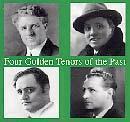 Preiser, the foremost label for historic
vocal recordings, offers a new series sampling legendary singers of
the past, grouped according to voice category or nationality or
both. "Four Great Italian Tenors" is representative of the
excellence of the series from both the technical and artistic points
of view. Listening to these arias by vocal lions Beniamino Gigli,
Aureliano Pertile, Giovanni Martinelli and Giacomo Lauri-Volpi
immediately puts our Three Tenors into perspective. These four are
different and yet complementary in their greatness. Gigli’s
legato, vocal velvet and ease is contrasted with Pertile’s
theatricality and vocal intensity, while Martinelli’s scrupulous and
modern musicality is balanced by Lauri-Volpi’s individual timbre and
way with a phrase. All recordings date from the period 1926 to 1930,
emphasizing the riches available during the interwar period. This
series is of value both in its own right and as a starting point for
further investigation. Essential. Preiser, the foremost label for historic
vocal recordings, offers a new series sampling legendary singers of
the past, grouped according to voice category or nationality or
both. "Four Great Italian Tenors" is representative of the
excellence of the series from both the technical and artistic points
of view. Listening to these arias by vocal lions Beniamino Gigli,
Aureliano Pertile, Giovanni Martinelli and Giacomo Lauri-Volpi
immediately puts our Three Tenors into perspective. These four are
different and yet complementary in their greatness. Gigli’s
legato, vocal velvet and ease is contrasted with Pertile’s
theatricality and vocal intensity, while Martinelli’s scrupulous and
modern musicality is balanced by Lauri-Volpi’s individual timbre and
way with a phrase. All recordings date from the period 1926 to 1930,
emphasizing the riches available during the interwar period. This
series is of value both in its own right and as a starting point for
further investigation. Essential.
- Arias. Olga Borodina,
mezzo-soprano
- Orchestra of the Welsh National Opera / Carlo
Rizzi
- (Philips 446-663)
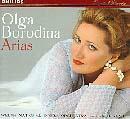 With her lush, brilliant tone, Russian
mezzo-soprano Olga Borodina offers listeners an astonishing variety
of arias in this recording of operatic gems. From the world of bel
canto, the arias from Les Huguenots and Semiramide
find her coloratura fluid and clear. Only the occasional passage in
the treacherous aria "Nacqui all’affanno" from Cenerentola
reveals an aspirate run or two. What a thrill to hear a big voice
manage bravura! Rizzi commands his orchestra in fine style, allowing
Borodina to shine, particularly in her three arias from Samson et
Dalila. She becomes the seductress, filling "Printemps qui
commence" with a wonderful sense of line and expansiveness. She
sings "Succombera sous mes efforts" and we succumb indeed.
Borodina’s handling of the two baroque arias on this disc is weaker.
We find Handel’s "Ombra mai fu" and Purcell’s "When I am laid"
marred by the occasional strange vowel in Borodina’s otherwise
passable English. Perhaps the most marvelous track on this disc is
Joan of Arc's aria from The Maid of Orleans. In this
brilliant piece Borodina matches Tchaikovsky at the height of his
musical and dramatic sensibilities. The orchestra sounds rich and
Borodina sounds particularly stunning, with sweeping phrases and
gorgeous tone throughout. Highly recommended. – Peter Phoa With her lush, brilliant tone, Russian
mezzo-soprano Olga Borodina offers listeners an astonishing variety
of arias in this recording of operatic gems. From the world of bel
canto, the arias from Les Huguenots and Semiramide
find her coloratura fluid and clear. Only the occasional passage in
the treacherous aria "Nacqui all’affanno" from Cenerentola
reveals an aspirate run or two. What a thrill to hear a big voice
manage bravura! Rizzi commands his orchestra in fine style, allowing
Borodina to shine, particularly in her three arias from Samson et
Dalila. She becomes the seductress, filling "Printemps qui
commence" with a wonderful sense of line and expansiveness. She
sings "Succombera sous mes efforts" and we succumb indeed.
Borodina’s handling of the two baroque arias on this disc is weaker.
We find Handel’s "Ombra mai fu" and Purcell’s "When I am laid"
marred by the occasional strange vowel in Borodina’s otherwise
passable English. Perhaps the most marvelous track on this disc is
Joan of Arc's aria from The Maid of Orleans. In this
brilliant piece Borodina matches Tchaikovsky at the height of his
musical and dramatic sensibilities. The orchestra sounds rich and
Borodina sounds particularly stunning, with sweeping phrases and
gorgeous tone throughout. Highly recommended. – Peter Phoa
- Bolero: A Spanish
Songbook
- Olga Borodina, mezzo-soprano
- Semyon Skigi, piano (Philips
446-708-2)
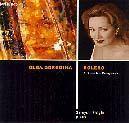 Borodina’s second solo recital
album is an unexpected foray into the Spanish repertoire. About half
the disc is devoted to "real" Spanish songs: de Falla’s 7
Canciones Populaires and melodies by Granados and Ravel. The
rest of the program is more bizarre: Shostakovich’s cycle of
Spanish Songs, Op. 100, set to Russian poems and sung in
Russian, and similar hybrids from Glinka, Rubenstein and
Dargomyzhsky. Of these Russian-Spanish songs, I can only quote Dr.
Johnson’s remark when he saw a dog walking on its hind legs: the
wonder is not that it is done well, but that it is done at all. Who
would have guessed that Russian and Soviet composers would have
dabbled in the Spanish idiom, especially since few had ever
travelled to Spain? So the curiosity value of this repertoire is
high but the musical value is modest and the pleasure minimal. Olga
Borodina is the best of Gergiev’s new wave of Russian singers but
her hard, monotonous timbre, limited expressive palette and
imperfect diction leave me cold. Borodina’s second solo recital
album is an unexpected foray into the Spanish repertoire. About half
the disc is devoted to "real" Spanish songs: de Falla’s 7
Canciones Populaires and melodies by Granados and Ravel. The
rest of the program is more bizarre: Shostakovich’s cycle of
Spanish Songs, Op. 100, set to Russian poems and sung in
Russian, and similar hybrids from Glinka, Rubenstein and
Dargomyzhsky. Of these Russian-Spanish songs, I can only quote Dr.
Johnson’s remark when he saw a dog walking on its hind legs: the
wonder is not that it is done well, but that it is done at all. Who
would have guessed that Russian and Soviet composers would have
dabbled in the Spanish idiom, especially since few had ever
travelled to Spain? So the curiosity value of this repertoire is
high but the musical value is modest and the pleasure minimal. Olga
Borodina is the best of Gergiev’s new wave of Russian singers but
her hard, monotonous timbre, limited expressive palette and
imperfect diction leave me cold.
- J.S. Bach: Goldberg Variations
- Masaaki Suzuki, harpsichord (BIS-CD-819 /
SRI)
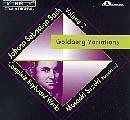 The latest in the flood of
recent recordings of this monumental work is from Masaaki Suzuki,
who studied organ and harpsichord with Ton Koopman and Piet Kee in
Amsterdam. Mr. Suzuki starts off with a sensitive interpretation of
the opening aria. The 30 ensuing variations are all technically
clean and precise. However, it is an almost too intellectual
performance: the notes are there but the joyful exuberance that
should be present is not. This CD lacks that magical spark that
makes the difference between a good recording and a great one. Mr.
Suzuki has the technical prowess to pull it off (note Variations 5,
14, 23, 26), but one wishes that he were a little less cautiously
correct. Even so, a likeable CD. -Casey Ann Reinke The latest in the flood of
recent recordings of this monumental work is from Masaaki Suzuki,
who studied organ and harpsichord with Ton Koopman and Piet Kee in
Amsterdam. Mr. Suzuki starts off with a sensitive interpretation of
the opening aria. The 30 ensuing variations are all technically
clean and precise. However, it is an almost too intellectual
performance: the notes are there but the joyful exuberance that
should be present is not. This CD lacks that magical spark that
makes the difference between a good recording and a great one. Mr.
Suzuki has the technical prowess to pull it off (note Variations 5,
14, 23, 26), but one wishes that he were a little less cautiously
correct. Even so, a likeable CD. -Casey Ann Reinke
- F. & L. Couperin: Works for
Harpsichord
- Dom André Laberge (Analekta FL 2 3090)
 Among the many hats he wears, Dom André
Laberge is a harpsichordist who studied with Gustav Leonhardt. On
offer here is the music of the illustrious Louis and François
Couperin. Dom Laberge's performance is restrained yet elegant,
controlled but oh-so style galant. Standouts include (in the
Sixth Order, 2nd Book of François Couperin, surnamed "le Grand")
"Les Langueurs-Tendres", which is appropriately languid and the
oft-heard "Les Barricades mistérieuses", which is good fun all
round, as well as an exquisite "La Ménetou", from the Seventh Order,
2nd book (supposedly evoking child prodigy Françoise-Charlotte de
Mennetoud). However, it is in the music of Louis Couperin that
Laberge outdoes himself. The lushly rich harmonies of the opening
"Prélude non mésuré" with its contrasting middle section and the
movements which follow are pleasing to the listener, everything is
carefully articulated but not square, and the labyrinth of ornaments
and unwritten code of conduct of French clavecin music is
masterfully navigated by Dom Laberge. -Casey Ann Reinke Among the many hats he wears, Dom André
Laberge is a harpsichordist who studied with Gustav Leonhardt. On
offer here is the music of the illustrious Louis and François
Couperin. Dom Laberge's performance is restrained yet elegant,
controlled but oh-so style galant. Standouts include (in the
Sixth Order, 2nd Book of François Couperin, surnamed "le Grand")
"Les Langueurs-Tendres", which is appropriately languid and the
oft-heard "Les Barricades mistérieuses", which is good fun all
round, as well as an exquisite "La Ménetou", from the Seventh Order,
2nd book (supposedly evoking child prodigy Françoise-Charlotte de
Mennetoud). However, it is in the music of Louis Couperin that
Laberge outdoes himself. The lushly rich harmonies of the opening
"Prélude non mésuré" with its contrasting middle section and the
movements which follow are pleasing to the listener, everything is
carefully articulated but not square, and the labyrinth of ornaments
and unwritten code of conduct of French clavecin music is
masterfully navigated by Dom Laberge. -Casey Ann Reinke
- Verdi: Il Trovatore
- Herbert von Karajan / La Scala (EMI
5563332)
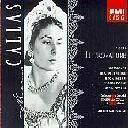 Callas’s only commercial Il Trovatore
(there are pirates from Mexico City 1950, Naples 1951 and La Scala
1953) is not one of the better Il Trovatore’s on the market.
Von Karajan, the La Scala forces and the chorus are hard to fault,
though recorded sound quality is typical for 1956, i.e., Verdi’s
great choruses and orchestral fortes are blurred. Callas
herself is in very good shape, sailing through the arias and easily
hitting her high notes. But her voice is metallic, lacking the
warmth that makes Leontyne Price’s Leonora so sympathetic. The
Azucena of Fedora Barbieri is impressive, sung in the rather polite
style of the day. The rest of the cast is a washout. Di Stefano is
too light for Manrico and that leads to unnerving patches of forced
production. Panerai is downright awful and Zaccaria’s oldish
Ferrando is ho-hum. Better to check out Price with Basile or Mehta
(both RCA) or even Karajan (EMI). Callas’s only commercial Il Trovatore
(there are pirates from Mexico City 1950, Naples 1951 and La Scala
1953) is not one of the better Il Trovatore’s on the market.
Von Karajan, the La Scala forces and the chorus are hard to fault,
though recorded sound quality is typical for 1956, i.e., Verdi’s
great choruses and orchestral fortes are blurred. Callas
herself is in very good shape, sailing through the arias and easily
hitting her high notes. But her voice is metallic, lacking the
warmth that makes Leontyne Price’s Leonora so sympathetic. The
Azucena of Fedora Barbieri is impressive, sung in the rather polite
style of the day. The rest of the cast is a washout. Di Stefano is
too light for Manrico and that leads to unnerving patches of forced
production. Panerai is downright awful and Zaccaria’s oldish
Ferrando is ho-hum. Better to check out Price with Basile or Mehta
(both RCA) or even Karajan (EMI).
- Verdi: Il Trovatore
- James Levine / Metropolitan Opera Orchestra
(Sony S2K 48070)
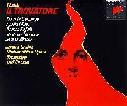 There haven’t been many great
Il Trovatore's recorded since the immortal sets by Price and
Tebaldi 30 years ago. Levine’s lively and compelling 1991 studio
version showcases several of today’s top singers in their best
roles. Aprile Millo’s covered, mezzoish soprano can be shrill at the
top, but she does a perfectly respectable job as Leonora. Russian
baritone Vladimir Chernov’s Di Luna gets better and better as the
opera progresses, culminating in a superb Act 2 "Il balen del suo
sorriso." Placido Domingo’s third recorded Manrico is generally
exquisite, though here and there the voice falters as if tired.
Mezzo Dolores Zajick’s stunning Azucena is of a uniformly high
quality. She is the undisputed star of the opera and makes this
recording a valuable document. Levine enforces zippy tempos and
exacts a precise performance from his choir and orchestra. Sony
engineering guarantees accuracy over atmosphere: the sound is highly
detailed, even tinny at times. This is a recording representative of
the state of the art, well worth owning for repeated listening.
The Opéra de Montréal performs Il Trovatore on February
14, 16, 19, 21, 25, 28 at 20h00. Tel. 985-2258. There haven’t been many great
Il Trovatore's recorded since the immortal sets by Price and
Tebaldi 30 years ago. Levine’s lively and compelling 1991 studio
version showcases several of today’s top singers in their best
roles. Aprile Millo’s covered, mezzoish soprano can be shrill at the
top, but she does a perfectly respectable job as Leonora. Russian
baritone Vladimir Chernov’s Di Luna gets better and better as the
opera progresses, culminating in a superb Act 2 "Il balen del suo
sorriso." Placido Domingo’s third recorded Manrico is generally
exquisite, though here and there the voice falters as if tired.
Mezzo Dolores Zajick’s stunning Azucena is of a uniformly high
quality. She is the undisputed star of the opera and makes this
recording a valuable document. Levine enforces zippy tempos and
exacts a precise performance from his choir and orchestra. Sony
engineering guarantees accuracy over atmosphere: the sound is highly
detailed, even tinny at times. This is a recording representative of
the state of the art, well worth owning for repeated listening.
The Opéra de Montréal performs Il Trovatore on February
14, 16, 19, 21, 25, 28 at 20h00. Tel. 985-2258.
- Zemlinsky: A Florentine
Tragedy
- Alma Mahler: Lieder
- Riccardo Chailly
- Royal Concertgebouw Orchestra
- (London 455-122-2)
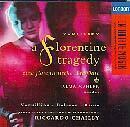 The Zemlinsky resurgence has reintroduced us
to many forgotten masterpieces, none more fascinating than his
one-act opera A Florentine Tragedy (1915-16). London/Decca’s
new recording is irresistible: fifty minutes of lushly scored
Straussian conversation dramatically bracketed by a mouthwatering
overture and a spellbinding final murder. Iris Vermilion (here
called a mezzo but elsewhere billed as a soprano) is a deliberately
hard-edged Bianca. Baritone Heinz Cruse sounds old (deliberately?)
as the cuckolded Simone. Albert Dohmen brings a clean, natural sound
and superb diction to his portrayal of Guido. Riccardo Chailly and
the Concertbegouw give a luxury performance of Zemlinsky’s
irridescent score. Six rather ho-hum songs by Alma Mahler fill out
the disc. The Zemlinsky resurgence has reintroduced us
to many forgotten masterpieces, none more fascinating than his
one-act opera A Florentine Tragedy (1915-16). London/Decca’s
new recording is irresistible: fifty minutes of lushly scored
Straussian conversation dramatically bracketed by a mouthwatering
overture and a spellbinding final murder. Iris Vermilion (here
called a mezzo but elsewhere billed as a soprano) is a deliberately
hard-edged Bianca. Baritone Heinz Cruse sounds old (deliberately?)
as the cuckolded Simone. Albert Dohmen brings a clean, natural sound
and superb diction to his portrayal of Guido. Riccardo Chailly and
the Concertbegouw give a luxury performance of Zemlinsky’s
irridescent score. Six rather ho-hum songs by Alma Mahler fill out
the disc.
La Diva II: Natalie Choquette, soprano,
The New Philharmonia Orchestra,
St-Petersbourg, Russie, Eric Lagacé, chef
ISBA Classic ISBCD 5043
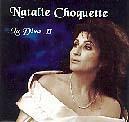 Dans son deuxième
disque-récital, Natalie Choquette nous offre onze airs d'opéra, un
duo chanté avec elle-même, et une mélodie, tous des morceaux
célèbres, en cinq langues. Dans son deuxième
disque-récital, Natalie Choquette nous offre onze airs d'opéra, un
duo chanté avec elle-même, et une mélodie, tous des morceaux
célèbres, en cinq langues.
C'est une chanteuse naturelle. On entend l'amour du chant. On
n'entend pas l'estampe académique. Sa voix est belle, ses aigus
superbes, pas de vibrato excessif ni d'''harmoniques" agressantes.
Par contre, elle manque de richesse et de puissance; son ton est
souvent trop doux ou retenu; et ses coloratures manquent parfois de
précision et d'agilité (e.g. "Je veux vivre" de Roméo et
Juliette, pour lequel elle a pourtant une couleur vocale
idéale).
Les airs lyriques lui conviennent bien mieux que "Vissi d'arte"
de Tosca et "Ave Maria" de l'Otello de Verdi. Il en va
de même pour les deux airs pour ténor: l'air lyrique de l'Indien de
Sadko est charmant, mais le "Nessun dorma" de Turandot
manque de puissance.
L'accompagnement orchestral est de meilleure qualité
que dans "Diva I". (N.B. Il ne s'agit pas du même New Philharmonia
que l'orchestre anglais des années 70.) Malheureusement, ces 13
pistes ne remplissent le disque qu'à 60% de sa capacité. C'est
inacceptable! Et le livret, qui est plutôt une affiche, ne contient
aucun détail sur les oeuvres. C'est regrettable. Néanmoins ce
disque, comme son prédécesseur, est une introduction amusante au
monde de l'opéra et de La Diva.
- Eric Legault
- Tenth Van Cliburn International Piano
Competition
- Jon Nakamatsu, piano, Médaillé d’or
- Harmonia Mundi - HMU 907219
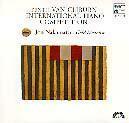 Depuis sa première
édition en 1962, le Concours International de piano Van Cliburn ne
cesse de promouvoir les jeunes talents du monde entier. Ce disque
regroupe les interprétations du médaillé d’or de la dixième édition
du concours en 1997. L’américain Jon Nakamatsu a choisi les 4
études opus 7 de Stravinsky, la Sonate en do majeur opus
1 de Brahms, l’Andante Spianato et la Grande
Polonaise opus 22 de Chopin ainsi que les Neuf
Bagatelles du compositeur américain William Bolcom. Ces
bagatelles avaient été spécialement commandées pour la dixième
édition du concours Van Cliburn. Depuis sa première
édition en 1962, le Concours International de piano Van Cliburn ne
cesse de promouvoir les jeunes talents du monde entier. Ce disque
regroupe les interprétations du médaillé d’or de la dixième édition
du concours en 1997. L’américain Jon Nakamatsu a choisi les 4
études opus 7 de Stravinsky, la Sonate en do majeur opus
1 de Brahms, l’Andante Spianato et la Grande
Polonaise opus 22 de Chopin ainsi que les Neuf
Bagatelles du compositeur américain William Bolcom. Ces
bagatelles avaient été spécialement commandées pour la dixième
édition du concours Van Cliburn.
En écoutant les études de Stravinsky, on ne peut que corroborer
le travail du jury. L’attention extrême apportée aux nuances
changeantes de ces pièces nous montre la sensibilité de Nakamatsu.
L’Andante Spianato de Chopin est adroitement interprété,
joué d’un bout à l’autre sans excès. Le jeu franc de Nakamatsu est
imparable. Cette humilité et paradoxalement, cette grandiloquence
qui transpire dans l’interprétation de I évoque les intentions d’un
jeune Chopin qui misait à l’époque sur cette pièce pour séduire
d’emblée les salles de concert et salons où il se produisait.
Les Bagatelles de Bolcom sont des pages d’une grande
virtuosité, rappelant parfois le post-romantisme de certains
compositeurs français. Le jeu à la fois puissant et furtif de
Nakamatsu nous donne un aperçu de son savoir-faire techniquement
parlant.
Enregistré en
public (ce qui est notable par les applaudissements en début et fin
de programme), ce DC qu'accompagne un livret détaillé présente un
artiste prometteur. Il s’adresse tant aux mordus qu’aux audiophiles
à la recherche d’une interprétation neuve. - Claudio A.
Nerraü
- Eileen Farrell Sings Verdi
- Columbia Symphony Orchestra/Max Rudolf,
Fausto Cleva.
- Sony MHK62358
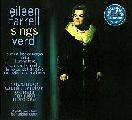 La soprano dramatique américaine Eileen
Farrell fut l'une des plus grandes artistes lyriques des années
50-60. Elle fut applaudie dans les plus grands théâtres lyriques du
monde, mais elle ne raffollait pas particulièrement de l'opéra. Elle
préférait le récital, où elle pouvait varier les styles. Sa
discographie, bien que trop courte, réflète cet ecclectisme: Verdi,
Puccini, Wagner, Berg, Schubert, Fauré, Gershwin, Berlin, etc. En
1955, elle a chanté et enregistré Medea (version remaniée
post-1850) de Cherubini, avec le ténor canadien André Turp. Les airs
inclus sur ce disque, qui vont d'Il Trovatore à
Otello, enregistrés en 1960, sont excellents. Elle a une
belle voix solide, chaleureuse, libre, un registre étendu qui
comprend une voix de poitrine bien développée, capable d'un grand
éventail d'expression. Elle a même l'agilité requise pour chanter
les deux airs de Leonora (Il Trovatore), trilles compris. Sa
maîtrise de l'italien et son sens dramatique sont excellents. Par
contre, son partenaire, le ténor populaire américain Richard Tucker,
vient enlaidir les duos, enregistrés en 1961, par son chant maniéré,
forcé et rauque. La partie récital solo représente toutefois le
chant verdien à son meilleur. La soprano dramatique américaine Eileen
Farrell fut l'une des plus grandes artistes lyriques des années
50-60. Elle fut applaudie dans les plus grands théâtres lyriques du
monde, mais elle ne raffollait pas particulièrement de l'opéra. Elle
préférait le récital, où elle pouvait varier les styles. Sa
discographie, bien que trop courte, réflète cet ecclectisme: Verdi,
Puccini, Wagner, Berg, Schubert, Fauré, Gershwin, Berlin, etc. En
1955, elle a chanté et enregistré Medea (version remaniée
post-1850) de Cherubini, avec le ténor canadien André Turp. Les airs
inclus sur ce disque, qui vont d'Il Trovatore à
Otello, enregistrés en 1960, sont excellents. Elle a une
belle voix solide, chaleureuse, libre, un registre étendu qui
comprend une voix de poitrine bien développée, capable d'un grand
éventail d'expression. Elle a même l'agilité requise pour chanter
les deux airs de Leonora (Il Trovatore), trilles compris. Sa
maîtrise de l'italien et son sens dramatique sont excellents. Par
contre, son partenaire, le ténor populaire américain Richard Tucker,
vient enlaidir les duos, enregistrés en 1961, par son chant maniéré,
forcé et rauque. La partie récital solo représente toutefois le
chant verdien à son meilleur.
- Eric Legault
- Opera Arias. Leonie Rysanek.
- Orchestres divers/Arturo Basile, Erich
Leinsdorf, Tullio Serafin
- RCA 09026-68920-2 BMG
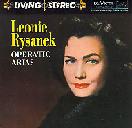 Bien que la soprano dramatique autrichienne
Leonie Rysanek soit reconnue pour ses interprétations de Wagner et
de Strauss, on la retrouve ici dans un répertoire italien en début
de carrière. Constitué principalement d'un récital réalisé en 1958,
ce disque est complété par deux airs et un duo (avec Jon Vickers)
tirés des intégrales de Macbeth et d'Otello. La voix
est belle et puissante, légèrement voilée, "crémeuse", les aigus
tranchants mais les graves faibles (du moins en 1958). Elle a une
voix idéale pour Aïda et Turandot. Son chant est expressif, malgré
sa tendance bizarre à omettre les "n". Elle manque d'agilité pour le
rôle de Lady Macbeth, mais elle compense par son sens dramatique. Le
livret ne contient pas le texte des airs, ni la biographie de la
chanteuse. Bien que la soprano dramatique autrichienne
Leonie Rysanek soit reconnue pour ses interprétations de Wagner et
de Strauss, on la retrouve ici dans un répertoire italien en début
de carrière. Constitué principalement d'un récital réalisé en 1958,
ce disque est complété par deux airs et un duo (avec Jon Vickers)
tirés des intégrales de Macbeth et d'Otello. La voix
est belle et puissante, légèrement voilée, "crémeuse", les aigus
tranchants mais les graves faibles (du moins en 1958). Elle a une
voix idéale pour Aïda et Turandot. Son chant est expressif, malgré
sa tendance bizarre à omettre les "n". Elle manque d'agilité pour le
rôle de Lady Macbeth, mais elle compense par son sens dramatique. Le
livret ne contient pas le texte des airs, ni la biographie de la
chanteuse.
- Eric
Legault
- Boito: Mefistofele
- Riccardo Muti / Teatro alla Scala
- RCA Red Seal 090226-68284-2
This live
Mefistofele, assembled from three performances at La Scala in
1995, is passable but not great. Sam Ramey had recorded the title
role better a few years previously (his 1992 video of the Ponnelle
production in San Francisco is infinitely more impressive). Sicilian
tenor Vicenzo la Scola is about as good a Faust as one gets these
days, with a pleasant Italianate sound but forced high notes.
Michèle Crider’s thick dramatic soprano, metallic and choppy, is all
wrong for the vulnerable young Margherita. Ernesto Gavazzi is a
sweet-voiced Wagner. Orchestra and chorus are splendid, ambient
noise is negligible, but one feels this wasn’t one of La Scala’s
more memorable weeks. Rudel’s recently reissued mid-price EMI
recording with Triegle, Caballe and Domingo beats Muti hands
down.
- China Girl: The Classical Album
2
- Vanessa-Mae, violin (EMI)
British violinist
Vanessa-Mae Vanakorn Nicholson (Vanessa-Mae, for short) recorded
three classical albums before her first pop album, the
multi-platinum The Violin Player (1995), featuring wet T-shirt
contest type photos and ditzy, oddly suggestive liner notes ("I have
had fun stretching myself and both my violins working on this album
..."), launched her as the latest underdressed fiddling babe (à la
Ofra Harnoy, Lara St. John, et al.). One year later Vanessa-Mae’s
Classical Album 1 (actually her fourth classical album) supposedly
sold over half a million copies in a fortnight. Now Vanessa-Mae
discovers her roots with China Girl: The Classical Album 2.
Actually, there is no classical music on this crossover album.
The Butterfly Lover’s Concerto is basically dim sum music, a
schmaltzy westernized orchestration of a few Shao-shing opera
themes. Naxos sold millions of its Butterfly Lovers recording (only
$7!), and no doubt EMI dreams of similar success.
- Bach: L’Art de la
Fugue
- Quatuor de Saxophones Nelligan
- Oratorio ORCD-4106 / Interdisc
This version of Bach’s Art of the Fugue for saxophone
quartet richly deserves a hearing. This is not a jazzy crossover
album but a serious musical adventure. The scoring for four
saxophones (soprano, alto, tenor and bartone) is at times
indistinguishable from an organ or an accordion, but the saxophones
have greater delicacy and individuality. The Quatuor Nelligan’s
playing is smooth and soothing with a lyrical and noble style
befitting Bach. |


